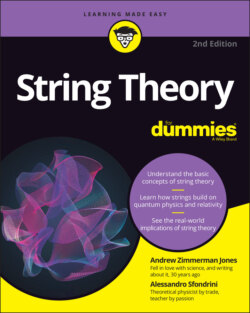Читать книгу String Theory For Dummies - Andrew Zimmerman Jones - Страница 96
Getting some good vibrations
ОглавлениеString theory depicts strings of energy that vibrate, but the strings are so tiny that you never perceive the vibrations directly, only their consequences. To understand these vibrations, you have to understand a classical type of wave called a standing wave — a wave that doesn’t appear to be moving.
In a standing wave, certain points, called nodes, don’t appear to move at all. Other points, called antinodes, have the maximum displacement. The arrangement of nodes and antinodes determines the properties of various types of standing waves.
The simplest example of a standing wave is one with a node on each end, such as a string that’s fixed in place on the ends and plucked. When there is a node on each end and only one antinode in between them, the wave is said to vibrate at the fundamental frequency.
Consider a jump rope that is held at each end by a child. The ends of the rope represent nodes because they don’t move much. The center of the rope is the antinode, where the displacement is the greatest and where another child will attempt to jump in. This is vibration at the fundamental frequency, as demonstrated in Figure 5-3a.
FIGURE 5-3: Examples of standing waves, demonstrating the first three normal modes of a string fixed at both ends. The top wave represents the fundamental frequency.
If the children get ambitious, however, and begin putting more energy into the wave motion of their jump rope, a curious thing happens. Eventually, the children will pump enough energy into the rope that instead of one large antinode, two smaller antinodes are created, and the center of the rope seems to be at rest, as shown in Figure 5-3b. It’s almost as if someone grabbed the middle of the rope and is gingerly, but firmly, holding it in place! (If you are a musician, you may recognize this as the second harmonic or first overtone of the rope.)
Another type of standing wave can be considered if instead of a child holding each end of the rope, one end is mounted on a ring around a pole. The child holding one end begins the wave motion, but the end on the pole is now unconstrained and moves up and down. Instead of having a node on each end, one end is a node (held by the child), and the other is an antinode (moving up and down on the pole).
A similar situation happens when a musician uses a pipe that’s closed at one end and open at the other, like pipes in an organ. A node forms at the closed end of the pipe, but the open end of the pipe is always an antinode.
A third type of standing wave has an antinode at each end. This would be represented by either a pipe that’s open on both ends or a rope that’s free to move on both ends.
The more energy that’s pumped into the standing wave, the more nodes form (see Figure 5-3c). The series of frequencies that cause new nodes to form are called harmonics or, in music, overtones. The waves that correspond to harmonics are called normal modes or vibrational modes.
Music works because of the manipulation and superposition of harmonic overtones created by these normal modes of vibration. The first three normal modes are shown in Figure 5-3, where a string is fixed on both ends.
In string theory, the vibrational modes of strings (and other objects) are similar to the vibrating waves that we are talking about in this chapter. In fact, matter itself is seen as the manifestation of standing waves on strings. Different vibrational modes give rise to different particles! We perceive the particles from the lowest vibrational modes, but with higher energies, we may be able to detect other, higher-energy particles.
